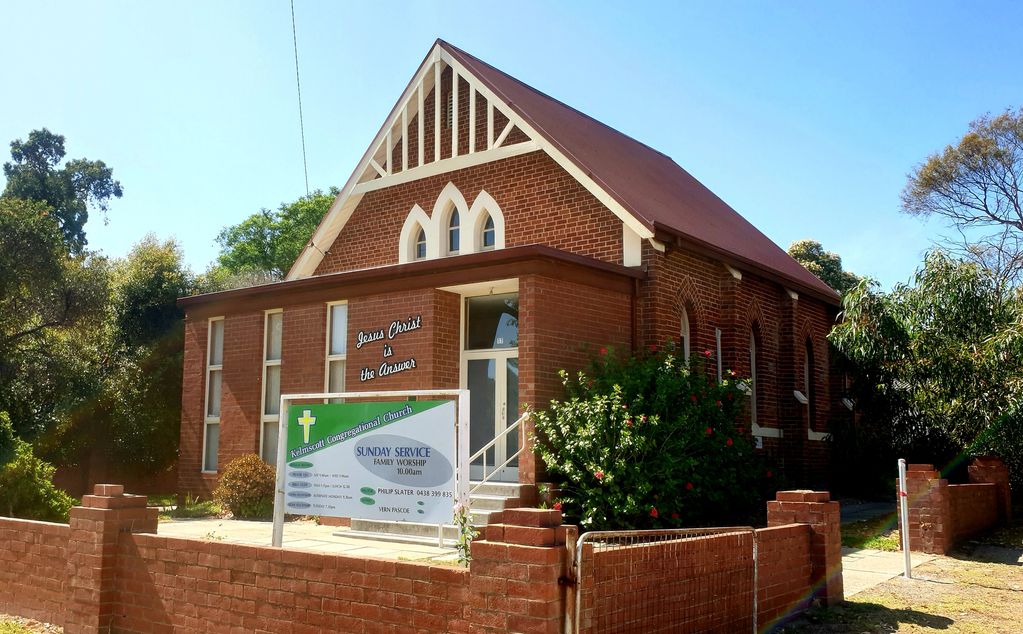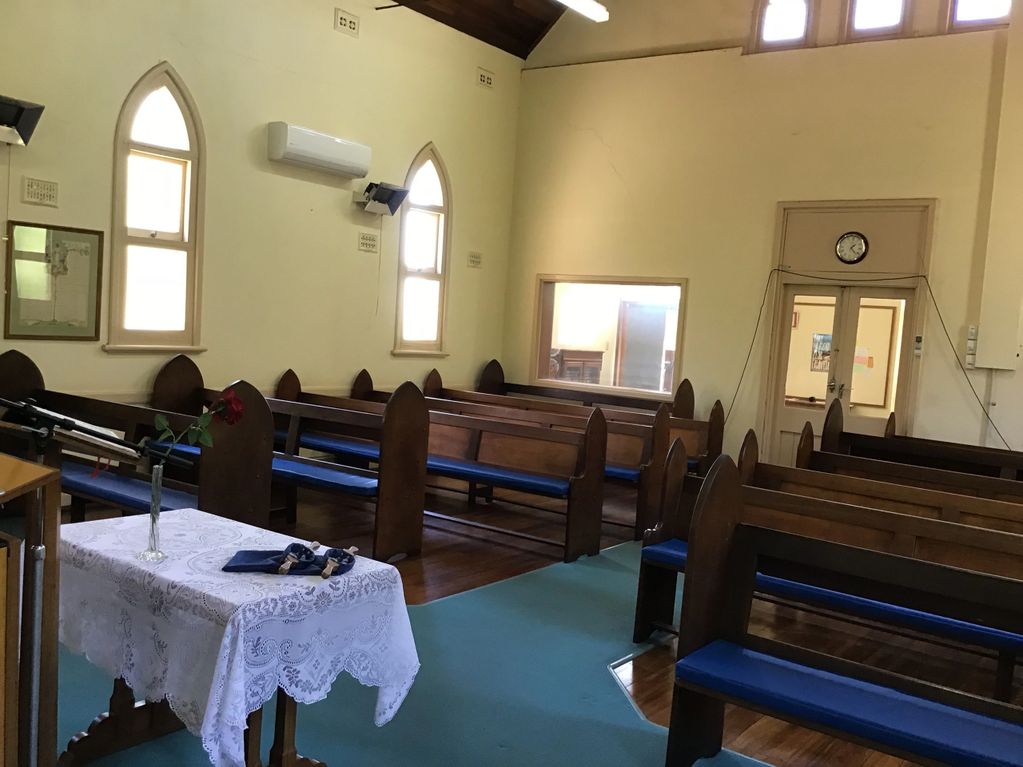


Church
The church for all your family,
proclaiming Christ for all your needs.
Sunday Service
10:00 AM
Pastor Philip Slater
# 0438 399 835
Youth Group:
180DegreeYouth
Age: 13-19
Saturday 7-9pm
Contact: # 0410 0175 563
Contact Us
Kelmscott Congregational Church
17 Rundle Street, Kelmscott Western Australia 6111, Australia
Minister/Pastor
Rev. Philip Slater
Graduate of:
* Illawarra Bible College. N.S.W.
* Baptist Theological College, W.A.
* Central School of Religion, U.K..
* Luther Rice Seminary, U.S.A.
Churches Pastored:
* Kojonup & Woodanilling Baptist.
* Scarborough Baptist.
* Dalwallinu Baptist.
* Maida Vale Baptist.
* East Fremantle Baptist.
* Kelmscott Baptist.
* Narrogin Baptist.
* Heritage Christian Church, Armadale
Other Ministries:
* Army Reserve Chaplain.
* Christian Radio broadcaster.
* Bible College lecturer.
Family:
* Married to Lois.
* Father of 3 daughters.
* Grandfather of 8.
What We Believe
STATEMENT OF FAITH: We believe in-
(a) God
· God is the Creator and Sustainer of the universe.
· God eternally exists as God the Father, God the Son Jesus Christ and God the Holy Spirit. Called ‘The Trinity’.
· God has revealed Himself to mankind generally in the miracles of nature and specifically in the Bible.
(b) Jesus Christ
· God entered human flesh in the Person of Jesus Christ through unique conception by the Holy Spirit using the womb of the virgin Mary.
· Jesus on earth was both totally God and totally human.
· He remained sinless even in a human body.
· Jesus confirmed His claim to be God by incredible miracles and revealed God to humanity in a way than humans could understand.
· He allowed Himself to be crucified on the cross to pay the penalty for the sins of mankind as our substitute.
· He rose from the dead in the body in which He was crucified and visibly appeared to over 500 people.
· He ascended into Heaven where He is our interceding High Priest.
· He will return at an unknown future date to snatch the true Christians from off the earth before the world will go through a seven year terrible time of Great Tribulation. After which He will return visibly with those He snatched (raptured) from the earth to set up His 1,000 year reign on the earth (Revelation chapter 20) after which is the Great White Throne Judgment Day and the final destinies of Heaven for the true Christian and Hell for the others.
(c) The Holy Spirit
· Is a Divine Person of the Godhead.
· At the point of the sinner’s repentance and salvation in Christ, He imparts new spiritual life into the new believer in which He indwells from that moment onwards.
· He baptises the new believer into the Body of Christ, the Church.
· He empowers the Christian to live a life pleasing to God.
(d) The Bible
· Is the verbally inspired record of God’s revelation to mankind. Called the Holy Scriptures.
· It is without error in the original manuscripts.
· Is the sole authority for the teachings and practices of our faith.
· It is God’s complete revelation of truth and does not need to be added to or updated. It transcends time and culture.
(e) Mankind
· God created male and female.
· Although created perfect, body, soul and spirit, Adam and Eve, the first two created, used their freewill to choose to sin. Consequently all mankind from birth is corrupted by sin and is dead spiritually.
· All are in need of salvation through Jesus Christ and to be made alive spiritually by the Holy Spirit.
(f) Salvation
· Salvation is not achieved by good works or church attendance.
· Sinners can only repent of sin and receive Jesus Christ as Saviour from their sin.
· The blood of Jesus Christ cleanses from all sin in the repentant sinner. Only then is the sinner justified by God.
· The sinner comes alive spiritually and can then be called a Christian and has everlasting life.
· The outward evidence of being a Christian is the on-going growth in holiness.
(g) The Church
· The universal church comprises all true born-again Christians throughout the world and history regardless of their denominational affiliation.
· The local church comprises of Christians in a locality meeting to glorify God, to have fellowship together, to build-up each other by teaching and learning and the exercising of the spiritual gifts of each individual and to fulfil Christ’s command to spread the Gospel of Christ to the world around.
(h) Baptism
· Baptism by immersion into water of believers is the God-appointed act of public identification with the death, burial and resurrection of the Lord Jesus Christ.
(i) The Lord’s Supper. (Communion)
· The Lord’s Supper in memory of Christ and His sacrificial death on the cross is to be celebrated by Christian until Jesus returns.
· The elements of bread and grape juice are not sacraments imparting salvation, but are mere symbols of Christ’s body and blood to remind us of what Christ has done for us.
· Non-Christians should not partake of the elements, but the Lord’s Supper is a proclamation of the Gospel to all who are present.
How To Become A Christian


Church Photo Gallery

Built in 1905.

The Sanctuary.

The proclamation of God's Word is central to the Church service.

Memorial Gardens

Ramp Access

Worship the Lord in the beauty of holiness.

Church History
BEGINNINGS OF CONGREGATIONAL CHURCHES WORLDWIDE
Queen Elizabeth I (1522 – 1603) as Queen of England and Ireland had the religious objective of enforced church uniformity and conformity. There were those, however, who repudiated the whole concept of a state church and favoured independence. These Christians were under the conviction of the Holy Spirit that the authoritative guide concerning spiritual things was Scripture alone. These became known as ‘Separatists’ and were the forerunners of those who later were termed ‘Congregationalists’. They contended that the church should consist only of those who had responded to the call of Christ and who had covenanted with Him and with each other to meet together as his disciples. Their definition of a ‘church’ was “Every company of Christian men and women, regularly organised for mutual fellowship is a church and stands in immediate relationship to the Lord Jesus Christ and is responsible to Him alone and is under the solemn obligation to allow no human authority, no pope or bishop or council or assembly or synod to come between Christ and itself.”
One history author enumerated four principles as clearly characteristic of mid-17th century Congregationalism and these have continued to be determinative:-
· The principle of SEPARATION – separation from evil, from the world and from the worldly church.
· The principle of FELLOWSHIP – fellowship within the particular church and with others of like mind.
· The principle of FREEDOM – manifesting in an unwillingness to submit to external authority, civic, ecclesiastical or creedal.
· The principle of WORTHINESS – in personal life and witness.
CONGREGATIONAL CHURCHES IN AUSTRALIA
In 1977, most Congregational churches belonging to the Congregational Union, joined the Uniting Church along with Methodist and Presbyterian churches. Only 27 churches in NSW, and smaller numbers in other states, chose to remain out of the Uniting Church and continue as independent Congregational churches. Most of these churches are linked in The Fellowship of Congregational Churches (FCC).
BEGINNINGS OF KELMSCOTT CONGREGATIONAL CHURCH
The first Congregational Church services in Kelmscott were held in a private home, 24th May, 1891. The preacher was Rev. Tremane Dunstan. Services moved to the Kelmscott public hall and Sunday night service and Sunday School began.
On 17th February 1901, some 23 foundation members officially formed Kelmscott Congregational Church.
The present church building was built and the foundation stone laid on 20th April 1905.
Copyright © 2024 Kelmscott Congregational Church - All Rights Reserved.
Powered by GoDaddy Website Builder